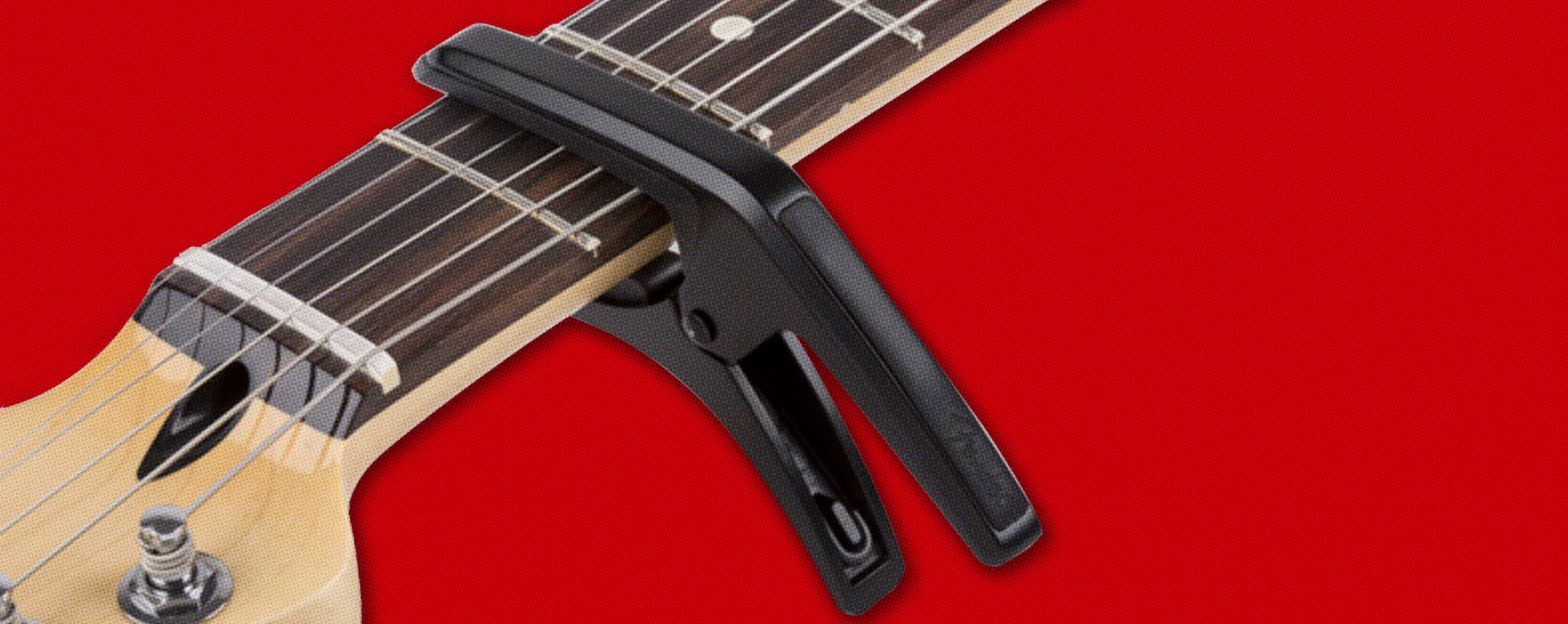2 Min ReadBy Mike Duffy
The Capo: 6 Things You Need to Know
How this unassuming accessory could help you expand your sound.

Some players think it’s cheating. Others find it an essential accessory in their gig bag.
While it might be controversial, the capo can be a solid addition to your practice and songwriting regimen.
Need more information as to why? Here are six truths about the unassuming capo:
1: A Capo Is Like a Moveable Nut
The nut of your guitar is one of two anchor points on your guitar that make up the length of string that vibrates and creates sound (with the other being the bridge saddles).
What a capo does is provide the same type of vibration termination, changing the pitch of your open strings without adjusting the tuning keys. It should be noted that the capo doesn’t have grooves in it to keep the strings in place, as the nut does. So essentially, a capo works in conjunction with the nut.
This not only gives you more options while you're playing, but it can also help if you’re a singer (or are playing with a vocalist). The ability to change your key and find the right pitch on the fly will ensure your playing matches your voice, while still enjoying the benefits of beautiful open chords.
2: You Can Experiment With Open Tunings
Once you’ve mastered basic chord shapes, a capo can quickly provide you with fresh voicings using those familiar fingerings by simply moving it up and down the fretboard.
In fact, it can unlock thousands of songs with the knowledge of just five chords, in addition to giving you the ability to create lush multi-guitar tracks by playing
3: There are Different Types of Capos
Depending on your preference, there is a wealth of capo varieties out there that are afixed to the guitar neck just behind the fretwire in different ways.
Toggle Capos
A toggle capo uses a notched mechanism to tighten it onto the strings.
Strap Capos
A strap capo is just what it sounds like—with an elastic, nylon or fabric strap.
Spring-Loaded Capos
Spring-loaded capos utilize a spring-controlled handle that allows the musician to pop it on and off with ease.
Screw-On Capos
A screw-on capo has a screw providing the pressure on the guitar’s neck.
Partial Capos
Another kind of capo is a partial capo, which only covers some of the strings.
4: You Don’t Need to Be an Expert to Use a Capo
Players have been using capos for ages—the earliest known use of the term "capotasto" is by Giovanni Battista Doni who, in his 1640 musical theory manuscript, Annotazioni, uses it to describe the nut of a viola da gamba.
In addition to unlocking more tonal options, a capo can also make playing chords easier on your hands. Playing up the guitar’s neck generally requires less pressure, and with the frets closer together the closer you get to the soundhole, there’s less distance for your fingers to travel.
5: Using a Capo Is Not a Crutch
Sure, if you rely on a capo 100 percent of the time, that could become a “crutch”, but in general it's a great tool to add to your practice.
The great Johnny Marr, for one, is a big proponent of using a capo, noting that it was essential in getting him past the difficult F and B-minor chords that many beginner players struggle to master.
Johnny Marr performing "How Soon Is Now?" with a capo on his signature Jaguar.
“That first position F and then B-minor, those two,” said Marr. “I really wanted to play B-minor because Mott the Hoople has their version of ‘Sweet Jane,’ and that’s the key chord. I was really struggling with that at about 11 or 12. One bit of advice I would give for people who are struggling with that cliff is get a capo and cheat.
“The Nashville guys used to call capos ‘cheaters’. Put a capo on the seventh fret even and learn how to play those chords and get those shapes changing, and then bit by bit, move the capo down and down.”
6: You Should Tune After Taking the Capo Off
Putting a capo on and off the guitar neck can knock the strings out of tune. Clamping it on pulls the strings down to the fretboard, while it also can tweak them when sliding it up and down the fretboard.
Download the Fender Tune app, visit the Fender online tuner or use a handy digital tuner to make sure you are in tune once you get back to playing.
Don’t miss out!
Be the first to know about new products, featured content, exclusive offers and giveaways.


